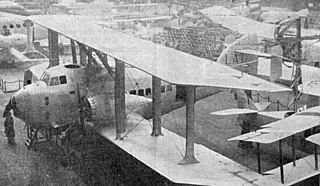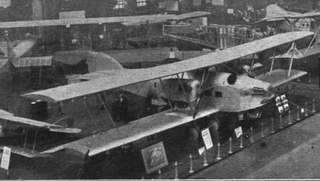
The Latécoère 4 was a three-engined, 15-passenger biplane built in France in the early 1920s. It proved difficult to fly and was discontinued, though a second machine was completed as the Latécoère 5 bomber.

The Potez XVIII was a French airliner from the early 1920s, a three-engine biplane carrying up to twelve passengers.

The Caudron C.27 was a French biplane, a two-seat basic trainer which also competed successfully in the 1920s.
The Caudron C.97 was a two-seat biplane trainer designed and built in France around 1924. A number were used by the Bolivian Air Force.
The Caudron C.91 was a French single engine biplane with an enclosed passenger cabin seating four. It first flew in 1923.

The Caudron C.74 was a ten-seat, four engine passenger biplane built in France in 1922. It showed promise but the sole prototype crashed fatally in a competition and no more were completed.

The Caudron C.68 was a two-seat French training and touring aircraft, built in the early 1920s, which attracted interest at the time because of its simple and fast wing folding arrangement. Only a few were produced.

The Caudron C.67 was a simple single seat biplane with a low powered engine. It was built and flown in France in 1922.

The Caudron C.43 was the first French five-engined aircraft, a biplane intended for passenger transport or military use and multi-engined for safety. A development of the three-engined Caudron C.39, it had one tractor configuration engine in the nose and two push-pull pairs between the wings. It was capable of carrying eight passengers but was not developed.

The Caudron C.39 was a French three-engined biplane with a cabin for six passengers when the aircraft was equipped as a landplane or four passengers when on floats. It was flown with some success in competitions in 1920 and 1921.
The Caudron C.37 was a French three-engined biplane passenger transport, built in 1920. It could carry six passengers.

The Caudron C.33 "Landaulet Monsieur-Madame" was a French twin engined biplane with four seats, two in open cockpits and two in an enclosed cabin.

The Caudron C.23 was a French long range twin engine night bomber, flown in the last year of World War I. Post-war some machines were modified to carry passengers.
The Caudron C.22 was a French twin engine night bomber built in 1917. It did not reach production.
The Caudron C.21 was a French twin engine biplane built just after World War I, able to carry three passengers in an open cockpit.
The Caudron Type H was a collective name for three different Caudron designs of 1912-3. One of these was an amphibious three seat biplane built for the French military. Two were completed, one appearing at the Paris Aero Salon in November 1912.

The Caudron Type L was a two-seat French pusher configuration amphibious biplane, flown around 1913 and intended for naval use.
The Caudron Type B was a 1911 development of the earliest Caudron type, the Caudron Type A, with a nacelle style fuselage and more powerful engine. Initially an equal span biplane, it was modified into a sesquiplane.
The Caudron Type B Multiplace was a large French biplane designed to carry up to five passengers in a cross-country time trial of 1912. It was destroyed early in the event.
The Caudron C.92 was a passenger transport built by Caudron in 1925, powered by a 370 hp (280 kW) Lorraine-Dietrich 12D. Only one was built, and it was discarded in July 1934.











